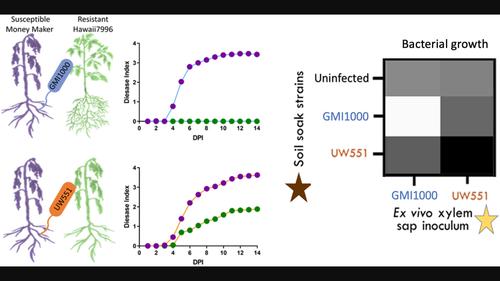当前位置:
X-MOL 学术
›
Mol. Plant Pathol.
›
论文详情
Our official English website, www.x-mol.net, welcomes your feedback! (Note: you will need to create a separate account there.)
Ralstonia solanacearum pandemic lineage strain UW551 overcomes inhibitory xylem chemistry to break tomato bacterial wilt resistance
Molecular Plant Pathology ( IF 4.9 ) Pub Date : 2023-10-17 , DOI: 10.1111/mpp.13395 Corri D Hamilton 1, 2 , Beatriz Zaricor 1 , Carolyn Jean Dye 1 , Emma Dresserl 1 , Renee Michaels 1 , Caitilyn Allen 1
Molecular Plant Pathology ( IF 4.9 ) Pub Date : 2023-10-17 , DOI: 10.1111/mpp.13395 Corri D Hamilton 1, 2 , Beatriz Zaricor 1 , Carolyn Jean Dye 1 , Emma Dresserl 1 , Renee Michaels 1 , Caitilyn Allen 1
Affiliation

|
Plant-pathogenic Ralstonia strains cause bacterial wilt disease by colonizing xylem vessels of many crops, including tomato. Host resistance is the best control for bacterial wilt, but resistance mechanisms of the widely used Hawaii 7996 tomato breeding line (H7996) are unknown. Using growth in ex vivo xylem sap as a proxy for host xylem, we found that Ralstonia strain GMI1000 grows in sap from both healthy plants and Ralstonia-infected susceptible plants. However, sap from Ralstonia-infected H7996 plants inhibited Ralstonia growth, suggesting that in response to Ralstonia infection, resistant plants increase inhibitors in their xylem sap. Consistent with this, reciprocal grafting and defence gene expression experiments indicated that H7996 wilt resistance acts in both above- and belowground plant parts. Concerningly, H7996 resistance is broken by Ralstonia strain UW551 of the pandemic lineage that threatens highland tropical agriculture. Unlike other Ralstonia, UW551 grew well in sap from Ralstonia-infected H7996 plants. Moreover, other Ralstonia strains could grow in sap from H7996 plants previously infected by UW551. Thus, UW551 overcomes H7996 resistance in part by detoxifying inhibitors in xylem sap. Testing a panel of xylem sap compounds identified by metabolomics revealed that no single chemical differentially inhibits Ralstonia strains that cannot infect H7996. However, sap from Ralstonia-infected H7996 contained more phenolic compounds, which are known to be involved in plant antimicrobial defence. Culturing UW551 in this sap reduced total phenolic levels, indicating that the resistance-breaking Ralstonia strain degrades these chemical defences. Together, these results suggest that H7996 tomato wilt resistance depends in part on inducible phenolic compounds in xylem sap.
中文翻译:

Ralstonia solanacearum 大流行谱系菌株 UW551 克服抑制性木质部化学,打破番茄青枯病抗性
植物病原性罗尔斯通氏菌菌株通过在包括番茄在内的许多作物的木质部导管中定殖而引起青枯病。宿主抗性是青枯病的最佳控制方法,但广泛使用的夏威夷 7996 番茄育种系 (H7996) 的抗性机制尚不清楚。使用离体木质部汁液中的生长作为宿主木质部的代表,我们发现罗尔斯顿氏菌菌株GMI1000在健康植物和受罗尔斯顿氏菌感染的易感植物的汁液中生长。然而,来自受拉尔斯顿氏菌感染的 H7996 植物的汁液抑制了拉尔斯顿氏菌的生长,这表明为了响应拉尔斯顿氏菌感染,抗性植物增加了其木质部汁液中的抑制剂。与此一致,相互嫁接和防御基因表达实验表明,H7996 枯萎病抗性在植物的地上和地下部分均起作用。令人担忧的是,H7996 的抗性被威胁高原热带农业的大流行谱系Ralstonia菌株 UW551所打破。与其他拉尔斯顿氏菌不同,UW551 在感染拉尔斯顿氏菌的 H7996 植物的汁液中生长良好。此外,其他拉尔斯通氏菌菌株可以在之前被 UW551 感染的 H7996 植物的汁液中生长。因此,UW551通过解毒木质部汁液中的抑制剂来部分克服H7996抗性。对一组通过代谢组学鉴定的木质部汁液化合物进行测试表明,没有任何一种化学物质能够差异性地抑制不能感染 H7996 的Ralstonia菌株。然而,受拉尔斯顿菌感染的 H7996 的汁液含有更多的酚类化合物,已知这些化合物参与植物的抗菌防御。在这种汁液中培养 UW551 降低了总酚水平,表明突破抗性的Ralstonia菌株会降解这些化学防御。总之,这些结果表明 H7996 番茄枯萎病抗性部分取决于木质部汁液中可诱导的酚类化合物。
更新日期:2023-10-17
中文翻译:

Ralstonia solanacearum 大流行谱系菌株 UW551 克服抑制性木质部化学,打破番茄青枯病抗性
植物病原性罗尔斯通氏菌菌株通过在包括番茄在内的许多作物的木质部导管中定殖而引起青枯病。宿主抗性是青枯病的最佳控制方法,但广泛使用的夏威夷 7996 番茄育种系 (H7996) 的抗性机制尚不清楚。使用离体木质部汁液中的生长作为宿主木质部的代表,我们发现罗尔斯顿氏菌菌株GMI1000在健康植物和受罗尔斯顿氏菌感染的易感植物的汁液中生长。然而,来自受拉尔斯顿氏菌感染的 H7996 植物的汁液抑制了拉尔斯顿氏菌的生长,这表明为了响应拉尔斯顿氏菌感染,抗性植物增加了其木质部汁液中的抑制剂。与此一致,相互嫁接和防御基因表达实验表明,H7996 枯萎病抗性在植物的地上和地下部分均起作用。令人担忧的是,H7996 的抗性被威胁高原热带农业的大流行谱系Ralstonia菌株 UW551所打破。与其他拉尔斯顿氏菌不同,UW551 在感染拉尔斯顿氏菌的 H7996 植物的汁液中生长良好。此外,其他拉尔斯通氏菌菌株可以在之前被 UW551 感染的 H7996 植物的汁液中生长。因此,UW551通过解毒木质部汁液中的抑制剂来部分克服H7996抗性。对一组通过代谢组学鉴定的木质部汁液化合物进行测试表明,没有任何一种化学物质能够差异性地抑制不能感染 H7996 的Ralstonia菌株。然而,受拉尔斯顿菌感染的 H7996 的汁液含有更多的酚类化合物,已知这些化合物参与植物的抗菌防御。在这种汁液中培养 UW551 降低了总酚水平,表明突破抗性的Ralstonia菌株会降解这些化学防御。总之,这些结果表明 H7996 番茄枯萎病抗性部分取决于木质部汁液中可诱导的酚类化合物。



























 京公网安备 11010802027423号
京公网安备 11010802027423号